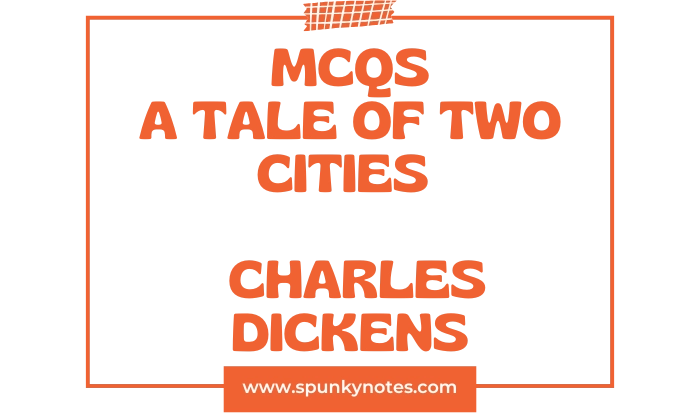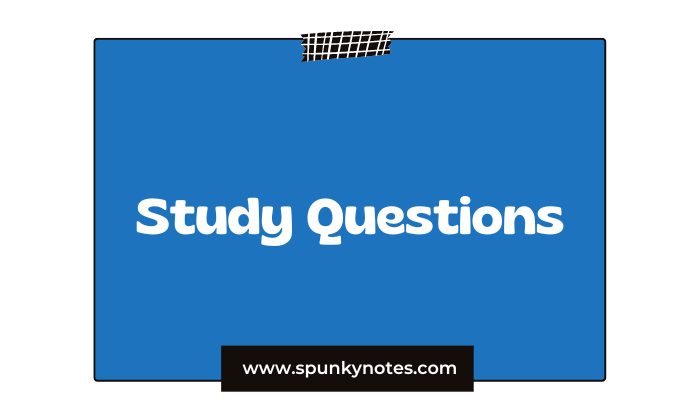
A Tale of Two Cities MCQs
1. What year does the novel state as the period of the events described?
A. 1770
B. 1776
C. 1775
D. 1789
2. What political figures are mentioned as being on the throne of England in 1775?
A. A large-jawed king and a queen with a fair face
B. A large-jawed king and a queen with a plain face
C. A king and queen both with plain faces
D. A fair-faced king and a plain-faced queen
3. In France, a youth was sentenced to be tortured and burned alive for failing to do what?
A. Attend Mass regularly
B. Pay homage to a nobleman
C. Kneel down to honor a procession of monks
D. Confess a crime
4. What terrible historical object is foreshadowed as being made from trees marked by Fate (the Woodman)?
A. A hanging scaffold
B. A movable framework with a sack and a knife
C. A prison cell door
D. A burning stake
5. What vehicle was struggling on the road to Dover?
A. A tumbril
B. The Dover mail
C. A private carriage
D. A post-chaise
6. If any passenger had proposed walking ahead into the mist and darkness, what was the risk?
A. Getting lost
B. Getting shot instantly as a highwayman
C. Catching a severe cold
D. Missing the connection
7. What was the name of the messenger who came galloping up to the stopped coach?
A. Tom
B. Joe
C. Jerry
D. Lorry
8. What specific Bank did the passenger, Mr. Lorry, belong to?
A. The Bank of England
B. Tellson’s Bank
C. Temple Bar Bank
D. The French Credit Bank
9. What answer did Mr. Lorry send back via the messenger, Jerry?
A. Mission accomplished
B. Recalled to Life
C. Waiting at Dover
D. Will depart tomorrow
10. How long had the buried person been buried, according to the spectral answers in Mr. Lorry’s mind?
A. Five years
B. Ten years
C. Almost eighteen years
D. Twenty-five years
11. What was Mr. Lorry’s most profound current of impression during the night journey?
A. That he was being pursued.
B. That he was on his way to dig someone out of a grave.
C. That he was late for a meeting.
D. That the horses were unfit for the journey.
12. What furniture made Miss Manette’s room look funereal?
A. Stone benches and straw
B. Iron chains and bars
C. White linen and fine carpets
D. Black horsehair and heavy dark tables
13. What did Mr. Lorry refer to himself as when addressing Miss Manette about business?
A. A wise counselor
B. A mere dull man of business
C. A speaking machine
D. An élderly gentleman
14. The history of Lucie’s father would have been the history of the unfortunate gentleman, the Doctor of what city?
A. Paris
B. Saint Antoine
C. Beauvais
D. Temple Bar
15. Who arrived to tend to Miss Manette after she fainted?
A. The waiter
B. The coachman
C. A strong woman
D. Jerry Cruncher
16. How did the strong woman (Miss Pross) indignantly address Mr. Lorry?
A. You business man
B. You in brown
C. Sir, you are a fool
D. Old gentleman
17. What liquid was spilled and broken in the street outside the wine-shop in Saint Antoine?
A. Water
B. Oil
C. Wine
D. Brandy
18. What did the miserable people in Saint Antoine have as an inscription on the baker’s shelves, even in his scanty stock of bad bread?
A. Poverty
B. Filth
C. Despair
D. Hunger
19. What was Madame Defarge doing with apparent calmness and repose of spirit?
A. Reading a book
B. Cleaning the counter
C. Knitting
D. Counting money
20. What distant landmark could be seen through the grating while ascending the staircase?
A. The Bastille
B. The two great towers of Notre-Dame
C. The Seine River
D. The King’s Palace
21. Who were the “chosen few” Defarge showed the shoemaker to, referred to as “real men of my name”?
A. Tellson’s agents
B. Revolutionaries
C. Jacques
D. The Patriots
22. What was the peculiar nature of the shoemaker’s voice?
A. It was deep and harsh.
B. It was the faintness of solitude and disuse.
C. It was cheerful and welcoming.
D. It was loud and angry.
23. When asked for his name, what did the shoemaker reply?
A. Alexandre Manette
B. Doctor of Beauvais
C. One Hundred and Five, North Tower
D. Citizen Jacques
24. What type of shoe was the shoemaker currently working on?
A. Practical boot
B. Lady’s walking-shoe in the present mode
C. Child’s shoe
D. A simple slipper
25. What did Manette tear in a frenzy upon uttering “Whose voice was that”?
A. His clothes
B. His white hair
C. The packet
D. The shoe
26. What object did the prisoner ask for miserably before getting into the coach?
A. Food and water
B. His shoemaking tools and unfinished shoes
C. The paper found in the cell
D. A new suit of clothes
27. What year did the second book, “The Golden Thread,” begin?
A. 1775
B. 1780
C. 1789
D. 1792
28. What attributes were the partners of Tellson’s Bank proud of?
A. Their generosity and modernity
B. Its smallness, darkness, ugliness, and incommodiousness
C. Its respectability and wealth
D. Its large size and good location
29. What was Charles Darnay indicted for?
A. Forgery
B. Robbery
C. Treason
D. Murder
30. What precaution was taken in the courtroom against “gaol air and gaol fever”?
A. Windows were opened.
B. The court was strewn with herbs and sprinkled with vinegar.
C. Guards wore masks.
D. Fires were kept burning constantly.
31. What was the name of the “unimpeachable patriot” witness for the Crown?
A. Roger Cly
B. John Barsad
C. Mr. Stryver
D. Sydney Carton
32. What was the name of the virtuous servant who testified against Darnay?
A. Gaspard
B. Theophile Gabelle
C. Roger Cly
D. Joe
33. What was the singular circumstance that arose in the case, discrediting a witness?
A. The witness admitted he was lying.
B. The witness confused him with the Judge.
C. The striking resemblance between Darnay and Mr. Carton.
D. The witness was blind.
34. Who was the first person to notice Lucie fainting and call for assistance?
A. Mr. Lorry
B. Doctor Manette
C. Sydney Carton
D. The Judge
35. What name did Lucie give to the influence that united her father to his past and present beyond his misery?
A. The silver cord
B. The golden thread
C. The quiet light
D. The happy echo
36. Why did Carton say he hated Darnay?
A. Darnay stole his career.
B. Darnay was too proud.
C. Darnay showed him what he had fallen away from.
D. Darnay was marrying Lucie.
37. What professional relationship existed between Sydney Carton and Mr. Stryver?
A. They were co-counsels.
B. Carton was the client, Stryver the lawyer.
C. Carton was the jackal, Stryver the lion.
D. Carton was the student, Stryver the tutor.
38. What item of his former life did Doctor Manette keep in a corner of his bedroom in London?
A. The Bastille Calendar
B. The disused shoemaker’s bench and tools
C. A portrait of Lucie’s mother
D. A safe from Tellson’s
39. What name did Miss Pross call Lucie?
A. My dear
B. Ladybird
C. Darling pretty
D. Miss Manette
40. How many strong men, besides the Cook, were required to assist Monseigneur in taking his morning chocolate?
A. Two
B. Three
C. Four
D. Six
41. Whose child was killed when the Marquis’s carriage dashed through the streets?
A. Gaspard’s
B. Defarge’s
C. The mender of roads’
D. Gabelle’s
42. Who threw the gold coin back into the Marquis’s carriage?
A. Gaspard (the wretched father)
B. Madame Defarge
C. Defarge
D. An anonymous member of the crowd
43. What was the Marquis’s governing philosophy?
A. Repression is the only lasting philosophy.
B. Liberty for all.
C. Justice and mercy.
D. Honesty and tradition.
44. What was scrawled on the paper around the knife hilt in the dead Marquis’s chest?
A. Justice for Gaspard
B. Drive him fast to his tomb. This, from Jacques.
C. Repression is dead
D. Recalled to life
45. For nine days after Lucie’s wedding, Doctor Manette suffered a relapse into what state?
A. Deep depression
B. Shoemaking seclusion
C. Agitated frenzy
D. Physical illness
46. What action did Mr. Lorry and Miss Pross take regarding the shoemaker’s bench?
A. They kept it safe.
B. They hacked it to pieces and burned it.
C. They sold it.
D. They moved it to the garden.
47. During the storming of the Bastille, Defarge of the wine-shop worked furiously, eventually demanding to be shown what cell?
A. The governor’s office
B. The North Tower, One Hundred and Five
C. The armory
D. The wine cellar
48. What did Defarge find in a hole in the chimney of the North Tower cell?
A. Weapons
B. A written paper
C. Gold and jewels
D. Food and water
49. What rumor, which proved true, sent the people of Saint Antoine into a blind frenzy?
A. The King was escaping.
B. Old Foulon, who told the starving to eat grass, was alive.
C. The Bastille had been retaken.
D. All prisoners were to be released.
50. What was the urgent communication that drew Charles Darnay back to France?
A. A note from Doctor Manette
B. A letter from Gabelle from the Abbaye prison.
C. A threat from the Marquis
D. A summons from the Republic
Brief Overview
Charles Dickens’ A Tale of Two Cities is set in London and Paris during the violent French Revolution. The story begins when Dr. Manette is freed from the Bastille after eighteen years.
His daughter, Lucie, whom he has never met, brings him back to life and sanity in England with the help of banker Jarvis Lorry.
In London, Lucie meets two very different men who love her. She marries Charles Darnay, a kind French aristocrat who has left his cruel family behind.
The other man is Sydney Carton, a brilliant but hopeless lawyer who looks precisely like Darnay. Lucie’s kindness deeply moves Carton, and he promises to sacrifice anything for her.
When the Revolution intensifies, Darnay travels to Paris to save a former servant. He is immediately arrested because he is a member of the hated Evrémonde family.
The revolutionaries, especially the vengeful Madame Defarge, want all aristocrats dead. Despite Dr. Manette’s efforts, Darnay is condemned to the guillotine.
To save the man Lucie loves, Sydney Carton fulfills his promise. He uses his identical appearance to enter Darnay’s prison cell, drugs him, and switches places. Darnay escapes to London with his family, while Carton goes to the guillotine, finding peace and redemption in his ultimate sacrifice.

